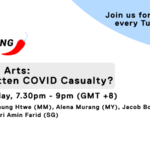Nepal-China Railway Project: Fantasy or Reality?
2022 - Film & Video (Film & Video)
15:39 minutes
Köken Ergun and Satyam Mishra
Nepal and China signed an agreement for the Belt and Road Initiative (BRI) in 2017. The BRI is a strategy that was set forth by China in 2013 to expand its influence by building a network of economic corridors around the globe. BRI projects in Nepal include the Kathmandu-Kerung Railway, the Galchhi-Rasuwagadhi-Kerung 400 kilovolt transmission line, the 762 megawatt Tamor hydroelectric dam, and the 426 megawatt Phukot Karnali run-of-the-river hydropower project. NEPALI POWER is a collaborative project by Köken Ergun and Tashi Lama composed of three vertical paintings that raise questions about the BRI’s infrastructure projects, critically considering both the positive and negative impacts the initiative will have on Nepal. This triptych of paintings is inspired by traditional Tibetan thangka painting, in which Lama is trained. The painting on the left is an impression of the Kathmandu-Kerung Railway project, while the painting on the right predicts how Nepal might export electricity to the greater region of South and Southeast Asia. The environmental and human repercussions caused by the construction of the BRI’s projects are portrayed in the details of both paintings. A third painting, in the middle of the triptych, vertically states the phrase “NEPALI POWER”. This third painting co-opted the language of propaganda rhetoric, while implicitly questioning whether the BRI initiative will move forward or not. In Ergun’s complimentary collaboration with Indian YouTuber Satyam Mishra, Ergun opened his extensive research archive on the BRI to different YouTube content creators around the world. He asked them to produce short YouTube commentaries using materials in Ergun’s archive, as well as other materials and footage they found from different open sources on the internet. The resulting YouTube videos comment on different aspects of Chinese-led projects in Nepal, ranging from the Kathmandu-Kerung Railway to various hydroelectricity projects that might shape a different future for Nepal in the region.
Since the early 2000’s artist Köken Ergun has been devoted to a transnational artistic practice, in which shifting identities of specific social groups in given contexts embody grand narratives of the world economy and new nationalist ideologies. His videos and installations are led by his exploration into how globalization has conditioned new forms of cultural identities. Ergun is particularly interested in different worlds being formed amongst non-dominant communities, such as the large global Filipino diaspora, or the global and regional networks of exchange and dominance established by various mid-size powers.
Colors:
Other related works, blended automatically
» see more

© » KADIST
Köken Ergun and Satyam Mishra
2022Nepal and China signed an agreement for the Belt and Road Initiative (BRI) in 2017...
Related works sharing similar palette
» see more

© » ARTS EQUATOR
Burning Questions: Traditional Arts: The Forgotten COVID Casualty? | ArtsEquator Thinking and Talking about Arts and Culture in Southeast Asia ArtsEquator Viewpoints July 28, 2020 While the pandemic has resulted in losses of jobs in the arts, less has been said about the fate of craftsmen, artisans and masters of intangible heritage and traditional arts...

© » KADIST
YOUNG-HAE CHANG HEAVY INDUSTRIES
2013Pacific Limn weaves together three narratives that comment on hyper-capitalism pan-Pacific cities that San Francisco exemplifies...
Other works by: » Köken Ergun and Satyam Mishra
» see more

© » KADIST
Köken Ergun and Satyam Mishra
2022Nepal and China signed an agreement for the Belt and Road Initiative (BRI) in 2017...
Related works found in the same semantic group
» see more

© » KADIST
Köken Ergun and Tashi Lama
2022Nepal and China signed an agreement for the Belt and Road Initiative (BRI) in 2017...

© » KADIST
Subas Tamang
2018Study of History IV by Subas Tamang is an etching and aquatint print based on photographs taken by German photographer Volkmar Wentzel in 1949...

© » LARRY'S LIST
Nepali art finds a new home | Nepali Times Nepali art finds a new home – Nepali Times Nepali art finds a new home MoNA is a permanent space for Nepali artists to showcase their work in Nepal itself Shristi Karki January 16, 2021 Museum of Nepali Art (MoNA), a private museum, opened to the public in February 2020...



